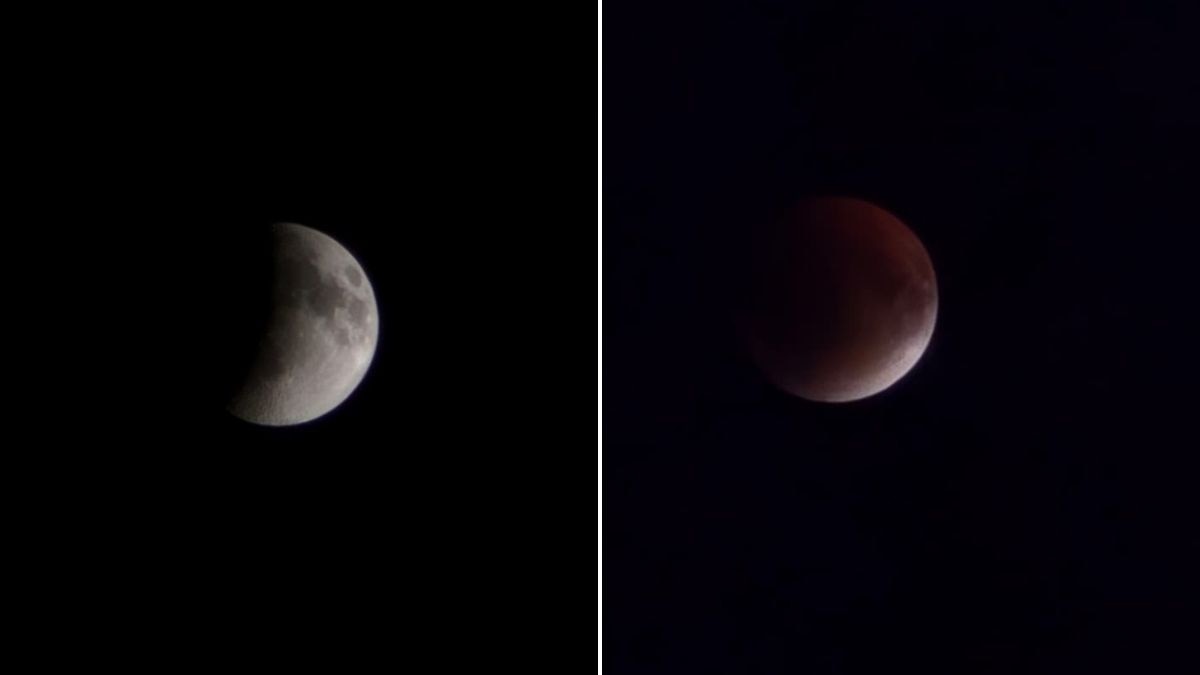
The eclipse reached its peak "blood moon" phase, where the Earth's shadow completely obscured the moon, diminishing its brightness.
Lunar Eclipse in India 2025: A spectacular celestial display lit up the skies on Sunday night as the Lunar Eclipse 2025 reached its full or ‘blood moon’ phase. During the rare event, Earth moved directly between the Sun and the Moon, casting a deep shadow that stripped the lunar surface of its natural glow and bathed it in a reddish hue.
From Ladakh to Tamil Nadu, skywatchers looked up as the moon turned coppery red during a rare total lunar eclipse, popularly known as the ‘Blood Moon’. The phenomenon began at 9:57 pm when the Earth’s shadow started creeping across the lunar disc, eventually reaching totality at 11:01 pm.
#WATCH | Thiruvananthapuram, Kerala | The #LunarEclipse enters the 'Red Moon' or the 'Blood Moon' phase pic.twitter.com/3ErbLNs0jc
— ANI (@ANI) September 7, 2025
The phenomenon, often called a ‘blood moon’, occurs when the Earth moves directly between the Sun and the Moon, casting its shadow across the lunar surface.
Explaining the reddish glow, B. S. Shylaja, former director of the Jawaharlal Nehru Planetarium, said, “The Moon appears red during lunar eclipses because the only sunlight reaching it is scattered and filtered through Earth’s atmosphere.”
#WATCH | Delhi | The #LunarEclipse enters the Total Phase or the 'Blood Moon' phase pic.twitter.com/R27Dohm2mP
— ANI (@ANI) September 7, 2025
Astronomers livestream rare event
To make the spectacle more accessible, the Indian Institute of Astrophysics trained telescopes at its campuses in Bengaluru, Ladakh, and Tamil Nadu on the Moon, streaming the eclipse live across social media. While cloudy skies dimmed the view in many regions, livestreams from astronomy enthusiasts worldwide ensured that enthusiasts did not miss the event’s dramatic progression.
The total eclipse was visible not only across India but also in much of Asia, and parts of Europe, Africa, and western Australia. According to astronomers, this was the first total lunar eclipse since July 27, 2018, visible across the entire country. The next such opportunity will arrive on December 31, 2028.
Rare but safe phenomenon
Astronomers explained that eclipses are uncommon because the Moon’s orbit is tilted about five degrees compared to Earth’s orbit around the Sun. Unlike solar eclipses, they emphasised, a lunar eclipse poses no risk. “It is perfectly safe to view with the naked eye, binoculars, or a telescope,” experts noted.
Myths vs science
In India, lunar eclipses have long been associated with superstitions — with some people avoiding food, water, or physical activity, fearing “poisoning” or “negative energy.” Others believe eclipses are dangerous for pregnant women.
Astronomers strongly rejected these claims. “Lunar eclipses are simply shadow phenomena, understood long before Aryabhata’s time, and they pose no threat to humans or animals,” said Ramanujam, adding that scientific awareness is vital to counter such beliefs.


0 Comments